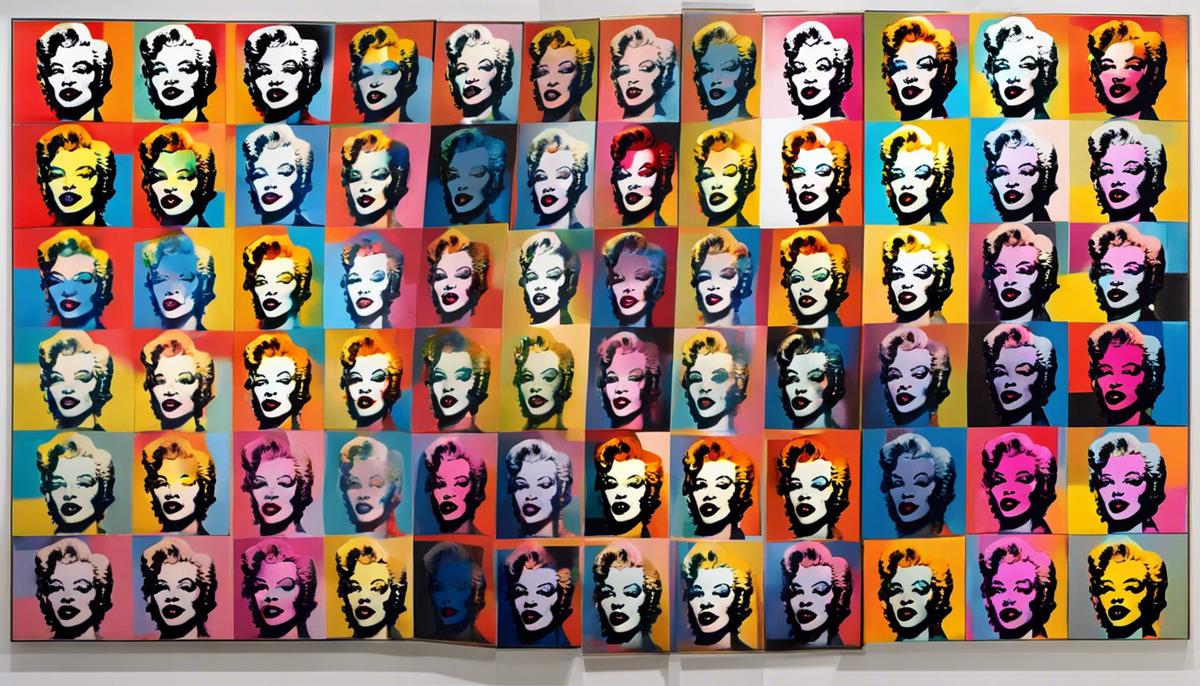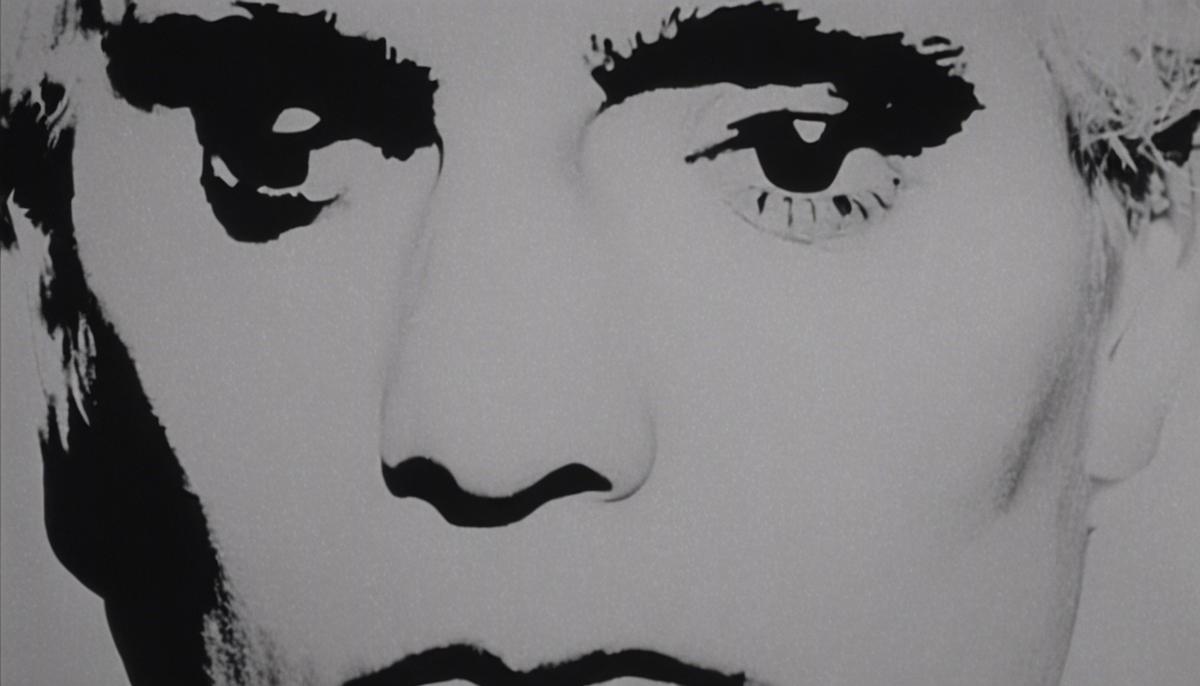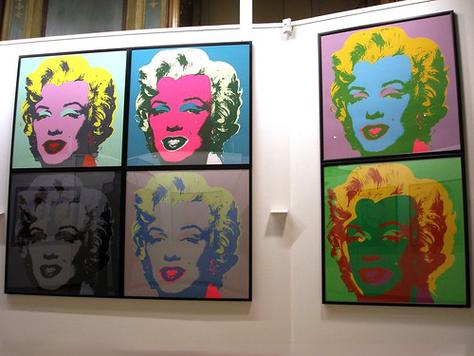Pop Art Evolution
Pop Art emerged as a vibrant counterpoint to the abstract expressions that dominated the 20th century's mid-era, reflecting upon and critiquing the burgeoning consumer culture of the time. Andy Warhol, born Andrew Warhola, was at the forefront of this movement, translating the language of advertising and celebrity into a form that was accessible yet complex.
Growing up in a working-class immigrant family in Pittsburgh, Warhol found solace and expression through drawing, a practice encouraged by his mother, an amateur artist herself. His education at the Carnegie Institute of Technology further honed his artistic talents.
Upon arriving in New York City in 1949, Warhol's initial success came as a commercial illustrator, where his skill in blurring the lines between the commercial and the artistic gained him acclaim. This dialogue between commercial illustration and art paved the way for Warhol's iconic 'Coca-Cola' bottles and Campbell's Soup cans. By bringing his art into the realm of the everyday consumer, Warhol challenged the pretensions of fine art.
His work during this period dismantled the barriers between art and commerce, repackaging what many considered mundane into something enigmatic and discussion-worthy. Warhol's embrace of silkscreen printing further demonstrated his commitment to exploring the production and reproduction inherent to pop culture. By adopting a commercial printing method and applying it to fine art, Warhol made art more accessible and critiqued a system that prized uniqueness over ubiquity. His assembly line art, created in his studio, The Factory, blurred authorship lines and challenged notions of originality.
Warhol's work also engaged profoundly with celebrity culture. From Marilyn Monroe to Elvis Presley, his portraits captured the essence of American culture's fixations, iconizing these personalities through repetition and variation. It was a commentary on fame, the repetition and saturation of images in media, and how society consumed these images.
Warhol's journey showcases an artist deeply entangled with the visual language of his time. His work cast everyday items in a new light, forcing viewers to reconsider their relationship with the visuals that populated their lives. Warhol dissolved the barriers between pop culture and art, rebalancing the scales of artistic value and turning the mundane into icons of the modern age. The impact of Pop Art, with Warhol as a key figure, continues to provide commentary on the ongoing dialogue between consumer culture and artistic expression.
Iconic Works Analysis
Delving into Warhol's Campbell's Soup Cans and Marilyn Diptych allows us to encounter the intellect that propelled Pop Art into the critical discourse of contemporary art history. These works underpin the concept of consumerism and serve as a testament to the entwining of celebrity culture with artistic pursuit, each carrying a narrative on the human condition and societal values.
The Campbell's Soup Cans, initially encountered as a bewildering commercial showcase, drove home the ubiquitous nature of consumer goods in America. Each of the thirty-two canvases mirrors a different flavor, replicating the varieties one might find on a grocery shelf. This series narrates the mundanity of its subjects, positing the quintessentially American product as both artifact and icon, ushering in a new ethos in fine art that lauds mass production and commercial aesthetics. It magnifies the idea of an 'art democracy' wherein the mass-produced can sit alongside the 'museum-worthy,' challenging notions of value and rarity in the art world.
The Marilyn Diptych wields a discourse on celebrity and mortality that resonates through its diptychal form. Warhol enshrines Marilyn Monroe's image into a form reminiscent of religious altarpieces. On one side, a vibrant array beams with color, an homage to Monroe's larger-than-life persona. The faded, repetitive imagery on the opposite pane reveals a stark contrast, symbolizing her tragic demise and the ephemeral nature of fame. It's a poignant reminder of the inevitable decline from icon to memory. As these faces fade into ghostliness, Warhol articulates a commentary on the cycle of celebrity: its creation, consumption, and eventual disintegration within the public consciousness.
Both series elevate the ordinary to the extraordinary, juxtaposing the products of consumer culture against questions about iconicity and identity. Warhol urges contemplation on how pervasive media imagery cultivates collective appetite and inner connectivity to objects and personas at the heart of American consumerism.
These pieces encapsulate Warhol's probe into themes of consumerism, celebrity, and mortality—setting a lens on how society venerates the warehoused and clamors after the immortalized image. By blurring the lines between high art and commercial fare, Warhol erected a mirror towards American society, embedding in his works an afterimage that continues to challenge viewers. His silk-screened surfaces, dense with meaning yet immediate in appeal, allow his philosophy to continuously rivet anew.
Warhol's Campbell's Soup Cans and Marilyn Diptych embody not just artistic evolvements but cultural phenomena that ushered in divergent thinking about art's place in society and its intersection with the quotidian. These masterpieces stand as hallmarks that have altered our visual and conceptual landscape, wherein Warhol's artistic skill commingles with his exploration of themes that are at once universal and uniquely American.

Warhol's Filmmaking
Warhol's foray into the world of moving images was not a mere dalliance but rather an expansive laboratory for the ideas permeating his static creations. In his films, as with his silkscreens and installations, Warhol seized the mundane eruptions of post-war Americana and distilled them into something unsettling yet familiar.
The late 1960s marked Warhol's incursion into filmmaking, with works ranging from the minimalism of Sleep – featuring a friend sleeping for over five hours – to the explicitness of Blow Job. From the vantage point of Warhol's espionage on the unextravagant, the static camera seemed to unveil an unexpected dimension where time dilated, inviting viewers to dwell in the temporal as a luxury, a meditation, or perhaps an endurance test mandated by pop philosophy. In stark opposition to Hollywood's story arcs, Warhol's films presented "real time," demanding a kind of patience seldom requisitioned.
With Empire, a single, static, eight-hour shot of the Empire State Building from dusk until dawn, Warhol turned what might be deemed a study in inertia into a monument of cinematic time-keeping. Here was stillness in locomotion, an homage to an icon wherein the edifice was rendered as celebrity and cinema as container of the concrete jungle's extended inhalation. Warhol was capturing not moments but the act of perception itself, suggesting that fame could be ascribed to time and stillness—a dismissal of narrative motion in favor of a meditation on presence.
In his Screen Tests, Warhol spanned the cavern between individual introspection and exemplification of fame. A blend of portrait and performance, these films encapsulated faces from the demimonde of The Factory era: subjects rendered motionless for the small eternity of a three-minute reel, inhabiting the duality of becoming 'famous for 15 minutes' while also laid bare. The likenesses created were both homage and examination, encapsulated eulogies to being seen, a testament to his enthrallment with the gravity of attention.
These ventures into film critiqued and expanded on his explorations within his physical art. His proclivity for repetition, exemplified in his serialized artworks, found a motion picture analogue in the rhythmic monotony and extended duration of his films, emphasizing recurrence as an instrument of aesthetic and temporal exploration. Here, Warhol illuminated the trenches between spectacle and spectatorship, urging a synthesis where each act of observation becomes an act of creation.
Warhol's filmmaking proved essential to understanding his oeuvre. We find an artist transfixed with the visage of popular culture and possessed by the mechanics of observation, the materiality of time, and the textures of fame. In effusing static art with dynamism and infusing film with minimalist pause, Warhol negated dichotomies of motion and stillness, surface and depth, fame and obscurity. He emerged not just as a passive envoy of the visual age but as its choreographer—his films an integral tessera in the mosaic of a career that redefined art and the lenses through which we apprehend modern life.

Legacy and Influence
Andy Warhol's fascination with the intersection of art and commerce reshaped not only the art world but also popular culture, weaving his legacy into a tapestry that extends into the digital age. Warhol's embrace of mass media and his cultivation of a personal brand have provided a blueprint for contemporary artists navigating the confluence of art, technology, and celebrity. His approach to art production, themes, and persona continues to resonate with a generation steeped in the ethos of visibility and virality, underscoring his influence on both the art they create and how they present it.
In the lineage of Warhol's influence, artists such as Damien Hirst, Jeff Koons, and Takashi Murakami emerge, flourishing under the ethos of the art factory model and blurring the boundaries between high art and commercial fodder. They adopt Warhol's strategy of delegating the physical creation of their work to others, underscoring the concept that the idea behind the art can be more critical than the hand that crafts it. This model democratizes the production of art and challenges the traditional artist-as-sole-creator narrative. Warhol's ghost smiles upon the bustling hives of creativity his successors helm, spaces where controversy, commerce, and commentary intertwine.
Warhol's thematic devotion to celebrity culture prefigured today's influencer-centric society, where fame often seems as commodified as the products those figures endorse. His portraits of Marilyn Monroe and Elizabeth Taylor portend a world where the line between person and persona is perpetually blurred, a prediction born out in the Instagram and YouTube personalities who curate their lives for public consumption. Warhol's own self-fashioning as a pop culture icon was visionary, his carefully cultivated image an early example of personal branding. Today's artists and celebrities owe their self-promotional strategies to Warhol's mastery of media manipulation and public persona creation.
Warhol's appreciation for repetition finds its echo in the incessant scroll of social media feeds and in the use of memes—a form that relies on recurrence and variation much like Warhol's silkscreen prints. In both cases, repetition serves as a means of embedding images and ideas in the collective consciousness, highlighting how Warhol's insights into media dynamics continue to apply in an era of digital ubiquity.
Perhaps Warhol's most enduring legacy is his vision of art as a mirror—a reflective surface upon which society's obsessions with fame, tragedy, and vanity are both scrutinized and celebrated. This role of art has never been more pertinent than in today's visually saturated culture, where the democratizing power of digital platforms enables a Warholian '15 minutes of fame' for virtually anyone with a smartphone. In this context, Warhol's work serves not only as an antecedent but as a prophetic lens, offering insights into a world he anticipated long before its digital dawn.
Andy Warhol's influence permeates the realms of visual art, film, and society at large, resonating in the processes by which art is made and marketed, and in the ways we construct identity and fame. His exploration of consumerism, celebrity, and media's power has never been more relevant, serving as a foundation and touchstone for artists navigating the complexities of contemporary culture. Warhol envisioned a world imbued with mass production and celebrity worship—a world he not only predicted but helped to shape, leaving an indelible mark that continues to foster dialogue, inspire artists, and provoke thought in our evolving cultural landscape.

- Danto AC. Andy Warhol. Yale University Press; 2009.
- Scherman T, Dalton D. Pop: The Genius of Andy Warh
























